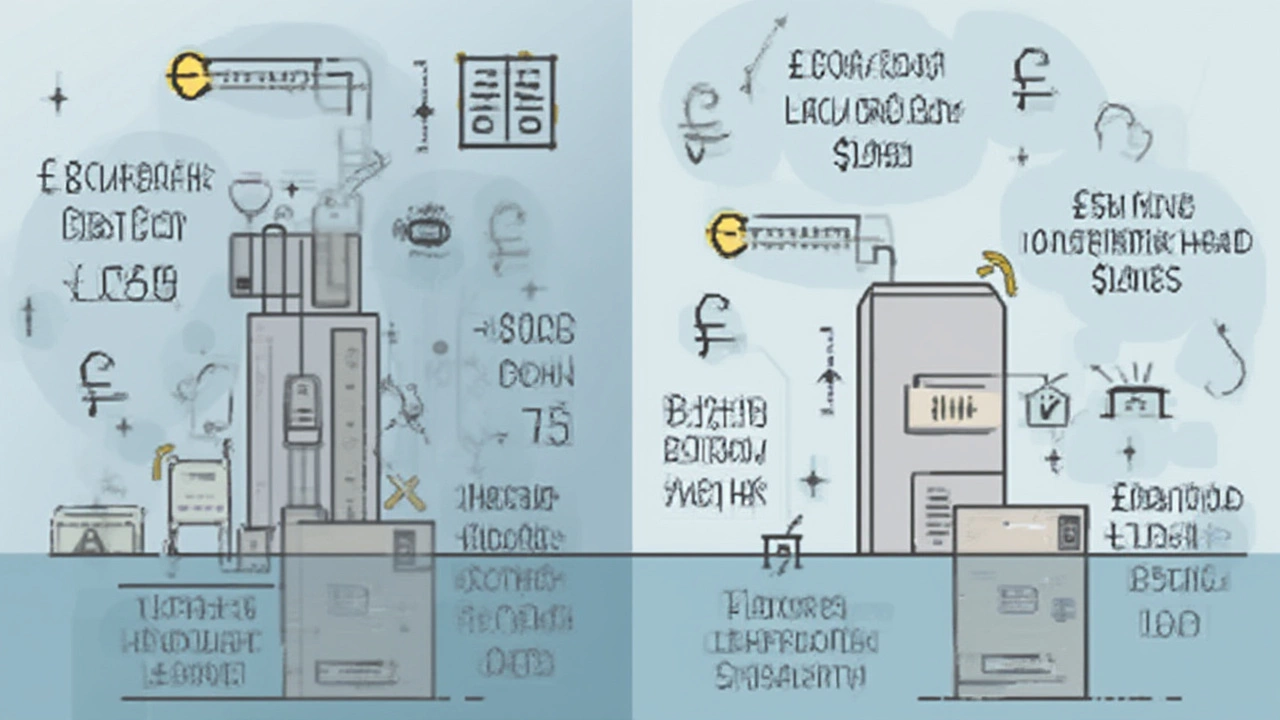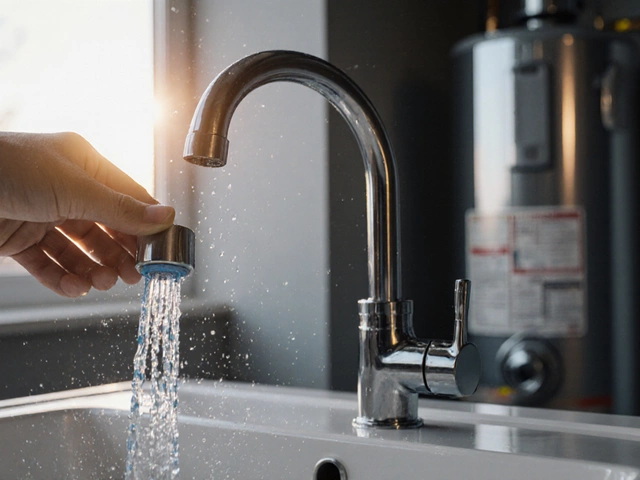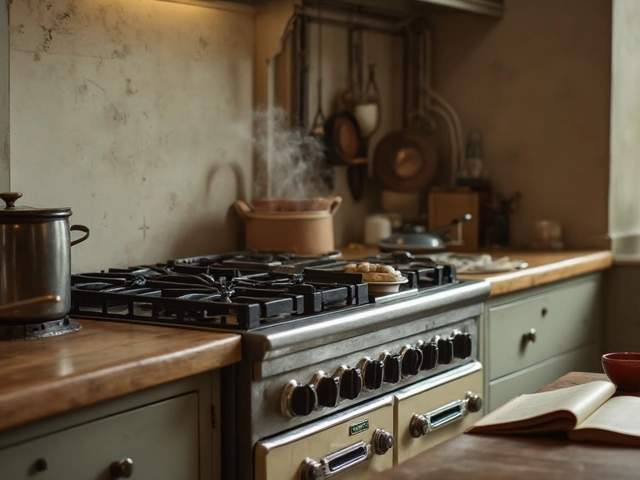Sticker shock. That’s usually where people start when they find out how much it costs to install a new boiler. It isn’t like dropping a few bucks on a kitchen gadget or splurging on a new power tool. Suddenly, you’re facing quotes in the thousands for something that lives quietly out of sight, only making its presence known when it breaks. Want to know why swapping out a boiler can make your wallet cry uncle? Let’s pull back the curtain on the real price tags, the hidden costs, and whether any of it makes sense in 2025.
The Layers Behind Boiler Replacement Costs
People usually think, "It’s just a metal box; how pricey can it be?" Here’s the thing: a modern boiler is a piece of precision engineering, stuffed with tech, safety features, and regulation-compliance that your granddad’s unit never saw. We’re not talking about a wood stove you install in an afternoon. In 2024, the average price for a new gas boiler—including installation—hit between £2,500 to £5,000 in the UK and $5,500 to $12,000 in the US. Prices are still climbing in 2025, and not just because of inflation.
First off, the actual equipment isn’t cheap. High-efficiency condensing boilers have more parts, and those parts are more expensive. Pump, heat exchanger, expansion tank—if you’re lucky, they all play together nicely. But if your house is older or has quirky plumbing, expect to pay extra for custom fittings. And unlike regular heating systems you can DIY, hiring a licensed pro isn’t optional. Rules got stricter after a string of scary carbon monoxide incidents, so cutting corners will get you flagged by building inspectors—and might even void your home insurance.
Most folks don’t see how many hands touch a single boiler replacement: surveyor, installer, plumber, electrician, and sometimes the gas company. Suddenly, the installation fee includes safety checks, old unit disposal, pipework, electrical upgrades, and ventilation. If you need a new flue or have to move the boiler’s location (think: kitchen to loft), expenses balloon. These hidden extras pile up fast—and that’s before you get to the surprise costs no one mentions at first: asbestos removal, cramped cupboard space, or outdated wiring. A 2023 survey by Which? revealed that nearly 43% of homeowners found hidden fees adding more than £1,000 to their boiler replacement bill.
Now let’s talk regulations. The push for greener, energy-efficient tech is a good thing, but it comes at a price. Starting in 2025, some countries require smart controls and low emission models by law. That nifty thermostat you like might need to be replaced if it doesn’t talk to your new boiler, and you’ll pay for the privilege. Manufacturers often bundle these extras, and skipping required upgrades isn’t allowed. Even location matters: tougher rules in London and New York jack up the costs compared to smaller towns.
Wondering about the breakdown? Here’s a table showing the average costs (data based on 2024 estimates):
| Cost Component | UK Average (£) | US Average ($) |
|---|---|---|
| Standard Boiler Unit | 900–2,000 | 2,000–4,000 |
| High-Efficiency Boiler | 1,200–3,000 | 3,500–8,000 |
| Labour (Basic) | 900–1,500 | 2,000–4,000 |
| System Upgrades | 300–1,000 | 500–2,000 |
| Miscellaneous (venting, thermostats, disposal) | 100–500 | 300–1,000 |
On top of that, if your old boiler system is "gravity fed" or needs rewiring, just factor in an extra grand—or more. All this to say, you’re not getting gouged by unscrupulous installers; you’re facing a wall of mandatory upgrades and labour that nobody can skimp on. If you want a tip: always get at least three quotes and dig into the fine print. Ask how much the extras cost up front. Some companies throw in a free warranty or annual servicing for the first year—haggling is allowed.
Finally, think about timing. Winter is busy season. Book in summer, when pros have less on their schedule, and you might save 10–15% or more. Plus, who wants to sit in a freezing house waiting for a spot to open up?

How Tech, Safety, and Energy Boost Costs
Remember those old horror stories about ancient boilers, flaking in the basement, making spooky noises but refusing to die? Most of us can’t get away with that anymore. New boilers have advanced safety sensors, automated shut-offs, smart thermostats, and eco-modes. All that tech means more expensive parts and specialized training for installers—no handyman can just "give it a go" now.
Think about what goes into a modern replacement. A strong part of the bill comes from the electronics. Since 2022, all new boilers in the UK and large US cities must meet upgraded efficiency standards—at least 90% efficiency for condensing models, up from the 70–80% you’d see in old appliances. That leap in performance means more sensors, extra insulation, high-grade materials, and built-in diagnostics so you can’t ignore routine maintenance. None of this comes cheap, but the flip side is, you save up to 30% on your annual heating bill, which, for a detached home in London or Boston, is about £250–£400 or $400–$800 per year. So, yes, you pay up front, but you get it back over time—if you stay in that house long enough.
Safety upgrades are another silent cost. After a series of carbon monoxide fatalities made the news in Europe in late 2023, regulations demanded tougher testing and new fail-safes. Now, every installer spends extra hours triple-checking gas connections, inspecting flues for blockages, and certifying that the system will automatically shut down if a problem pops up. You literally can’t skip this step. These safety checks and certifications can add a few hundred more to your final bill but make a life-or-death difference.
Let’s not forget the impact of energy incentives and government rules. Some countries offer rebates for high-efficiency boilers—a few hundred quid or bucks off if you hit the right spec. But there’s a catch: you usually must pay for extra documentation, inspections, or installer registration fees to qualify. Many folks don’t budget for this, so it can feel like a never-ending pile-on. Dig into local schemes—sometimes, a utility company or city government covers part of your bill, but only works with approved contractors. One hot tip: ask installers if you qualify for any grants, and get them to apply for you. Some do all the paperwork, which saves you time (and maybe a headache or two).
There’s also a backup system to consider. In colder climates, regulations might push you to install a secondary heat source or backup power supply for emergencies. Solar-assisted boilers or hybrid systems are becoming more common, but they cost more up front. In some Canadian provinces and northern US states, new builds need a dual-fuel system by law—so if your eye’s watering at the cost, you’re not alone.
Here’s what you should ask installers before starting:
- Does the quote include all safety inspections and certifications?
- Are there any discounts or government rebates available?
- Will my old thermostats and controls work with the new boiler?
- What’s the warranty length, and is servicing included the first year?
- Are there extra costs for emergency callouts or replacements parts in year one?
Don’t skip maintenance, either. Annual servicing costs around £80–£150 or $120–$250, but skipping it voids most warranties. If you’re already laying out cash for a fancy new boiler, spending a couple hundred a year keeps it running smooth—think of it like an oil change on a car, except this is essential for keeping your house habitable. Preventative calls catch problems early, which can save thousands in the long run.

Saving on Boiler Replacement: Smart Moves and Myths Busted
Let’s get real for a minute—nobody likes dumping money into things they can’t show off to friends. Boilers aren’t sexy, but a freezing morning shower will remind you how much you need one. So, is there any way to make this epic spend less painful?
First up, don’t be fooled by "cheap install" deals you see online. They usually cut corners, ignore local codes, or slap in an undersized unit that can’t keep up once winter hits. In fact, Which? magazine found that one in five budget installs led to a second callout within the first year—costing homeowners more than the "expensive" quote would have. If your quote seems suspiciously low, double-check what’s really included. A pro installer should walk you through every step, explain the right unit size for your space, and be happy to show certifications and insurance.
Shopping around is important. Get at least three quotes from licensed pros, not just the local guy with a van. Read reviews, ask neighbors, and check for customer complaints on trusted sites. Some national brands offer fixed-price installs, which means no extras—handy for budgeting, especially if your house has hidden surprises like old electrics or surprise pipework reroutes.
One overlooked tip: check if you need a new boiler at all. Sometimes a solid servicing or replacing a worn part (like a pump or diverter valve) gives you a few more years. If your current boiler is less than 10 years old and problems aren’t chronic, a good tech can keep it humming for a fraction of replacement cost.
You also want to know the lifespan of different boiler types. Combination boilers (heating + hot water in one unit) usually last 10–12 years; conventional models with hot water tanks might push 15–20 years with good care. If you’re moving house soon, ask if the replacement adds value—a brand new boiler can tip the scale for buyers, so you may reclaim some cash at sale.
Here’s one bright spot: new smart tech can cut heating bills even if the initial buy stings. Programmable thermostats, zone controls, and load monitoring help you use less energy, and many insurers now offer lower premiums if your system has safety shut-offs (a win-win for peace of mind and your wallet). Another money-saver: bulk deals. If your area has lots of old houses, talk to your neighbors. Some companies give group discounts if they can swap multiple boilers in a street at once. Weird trick—but it works in practice.
For renters and landlords, keeping up with annual servicing is crucial—not just for safety, but because local authorities check certificates. Skipping a single inspection can lead to steep fines, or worse, insurance getting voided if something goes wrong. If you’re a landlord, factor maintenance costs into monthly rent—it’s cheaper than dealing with emergencies later.
Want to avoid nasty surprises? Keep an eye (and an ear) on your system. Unusual noises, sudden changes in heating habits, slow hot water, or pressure loss all say "call a pro." Don’t wait for total failure. A smart move is to budget for replacement from the day you get the new one. Stick a little aside every month—like a boiler rainy day fund. That way, whenever the next big replacement day comes around, you’re not left scrambling for cash.
If you’re looking for the silver lining, modern boilers are quieter, safer, and way more efficient than anything from the past. Yes, the up-front cost stings, but your house will be cozy, your bills smaller, and you’re unlikely to ever deal with the old chills or dangerous fumes again.
The bottom line: boiler replacement just isn’t cheap in 2025. Between tech upgrades, stricter codes, and necessary extras, the price is the price. If you go into it with your eyes open, armed with the right questions, and a couple of quotes in your pocket, you’re in a good place to tackle this big-ticket home upgrade.





